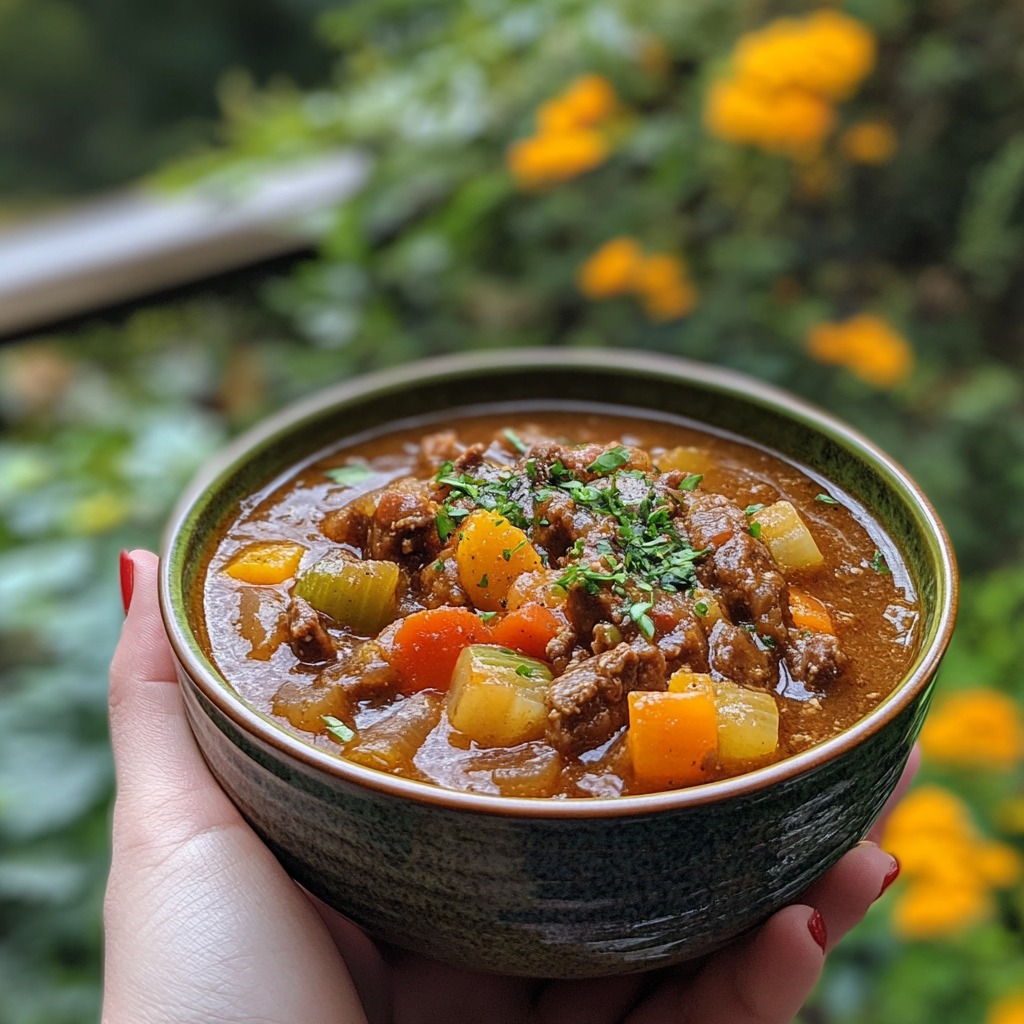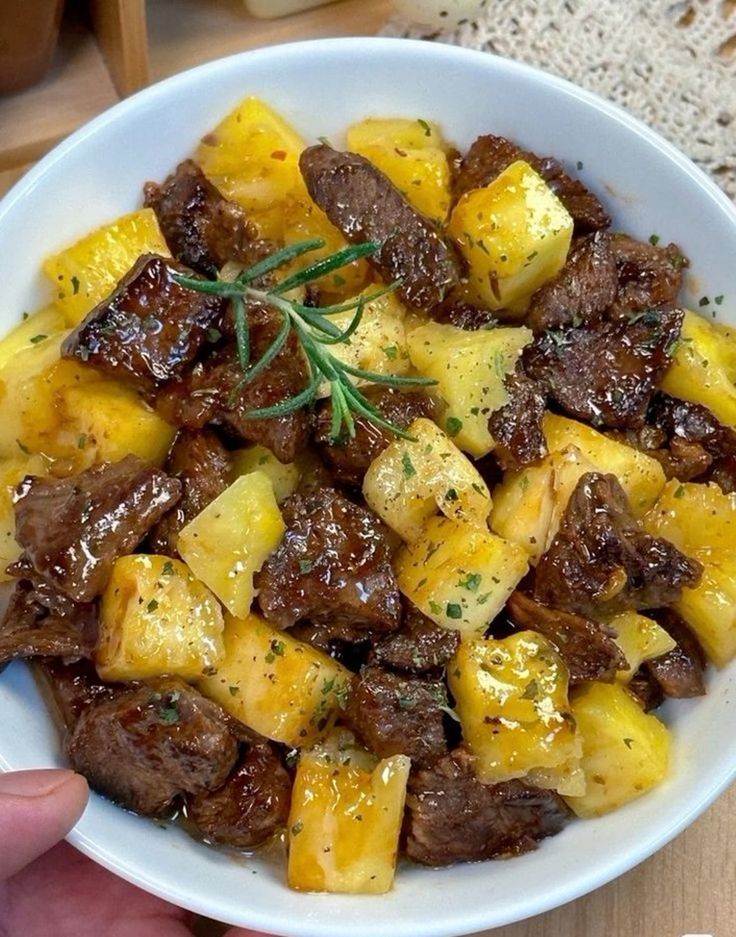Introduction to Beef Stew
Beef stew is a beloved dish that combines simplicity and heartiness, making it a quintessential comfort food in many cultures around the world. The origins of beef stew can be traced back to ancient times when various societies utilized the slow-cooking technique to tenderize tougher cuts of meat while enhancing flavors through the combination of ingredients. This method has evolved over centuries, and today, it remains a staple in many households and culinary traditions.
At its core, a traditional beef stew includes an array of essential ingredients. The primary component is, naturally, beef—often sourced from tougher cuts such as chuck or brisket that benefit from slow cooking. Vegetables typically include carrots, onions, and potatoes, which contribute to the dish’s nutritional value and flavor. Broth or stock serves as the base, allowing the ingredients to meld together and develop a rich taste. Seasonings such as herbs, spices, and sometimes even wine, further enhance the depth of flavor.
The preparation of beef stew often involves a method called braising. Initially, the beef is browned in a pot to create a savory crust, which adds complexity to the overall dish. Once the meat is seared, it is combined with the vegetables and liquid, and then simmered over low heat for several hours. This results in a thick, flavorful stew where the meat becomes tender and the vegetables absorb all the wonderful tastes from the beef. The comforting aroma of a simmering beef stew has the unique ability to evoke feelings of warmth and coziness, making it a perfect meal for gatherings and colder days. As we explore various beef stew recipes and their delightful variations, we will uncover how cultural influences shape this timeless dish, ensuring a culinary experience that appeals to every palate.
Essential Ingredients for a Perfect Beef Stew recipe

Creating a classic beef stew requires a selection of essential ingredients that contribute to the dish’s rich flavors and hearty texture. One of the most crucial components is the choice of beef cut. Chuck roast is widely regarded as the ideal cut for beef stew due to its balance of meat and fat, which breaks down beautifully during the long cooking process. Brisket is another option, offering a slightly different flavor profile while remaining tender and rich.
Vegetables play an integral role as well. Onions are foundational for building flavor, as they caramelize and infuse the stew with sweetness. Carrots add a subtle brightness and sweetness, complementing the beef. Potatoes are essential for heartiness; they absorb surrounding flavors while providing texture. It is advisable to use waxy potatoes, such as Yukon Gold, as they hold their shape better than starchy varieties during cooking.
In addition to these primary ingredients, herbs and spices are pivotal for enhancing the stew’s complexity. Fresh thyme and bay leaves are classic choices, offering earthy notes that deepen the overall flavor. Garlic, though optional, can add a robust aroma and taste. A good quality beef broth or stock is vital; it serves as the stew’s base, bringing depth to the dish. For added richness, some recipes suggest a dash of red wine, which can elevate the stew to a new level of sophistication.
Quality matters in every ingredient. Selecting fresh, high-quality produce and meat will ensure the best possible stew. Proper preparation, such as browning the meat before simmering, also contributes significantly to the overall flavor development. Utilizing these essential ingredients will set the stage for a memorable and delightful beef stew, appealing to a wide range of tastes while satisfying the palate.
Step-by-Step Guide to Make Classic Beef Stew
STEP1
Preparing a classic beef stew involves a series of systematic steps that ensure a flavorful and tender dish. To start, select the right cut of beef, such as chuck roast, which becomes tender when slow-cooked. Cut the meat into uniform cubes, typically about 1.5 inches thick, to ensure even cooking.
STEP2
Next, it is crucial to brown the meat effectively. Heat a few tablespoons of oil in a heavy pot or Dutch oven over medium-high heat. When the oil is shimmering, add the beef cubes in batches, ensuring not to overcrowd the pot. Brown each piece on all sides, which takes about 5 to 7 minutes. This step caramelizes the meat, enhancing the overall flavor of the stew.
Once the beef is browned, remove it from the pot and set it aside. In the same pot, add chopped onions, carrots, and celery, known as mirepoix. Sauté the vegetables until they become soft and translucent, approximately 5 minutes. The fond left at the bottom of the pot can be deglazed by adding a splash of red wine or broth, scraping up any browned bits.
STEP3
Return the beef to the pot, adding enough beef broth to cover the ingredients. Season the mixture with salt, pepper, and herbs such as thyme or bay leaves. Bring the stew to a gentle simmer, reducing the heat to low, and cover the pot. It is essential to simmer the stew for at least 1.5 to 2 hours, stirring occasionally. Longer cooking times will deepen the flavors and tenderize the meat further, ideally reaching a point where it falls apart with a fork.
In the last 30 minutes of cooking, you may include additional vegetables, such as potatoes or peas, to enhance the stew’s heartiness. Once the cooking time is complete, the beef stew should have a rich consistency and flavor. Allow it to sit for a few minutes before serving, which lets the flavors meld perfectly, resulting in a comforting and satisfying dish.
Variations of Beef Stew: From Regional to Creative Twists
Beef stew, a comforting dish cherished across the globe, boasts a myriad of variations that reflect regional culinary traditions and personal creativity. Renowned for its rich flavors and hearty ingredients, each variation brings a unique twist to the table. One notable example is the Irish Beef Stew, which features tender chunks of beef simmered slowly with potatoes, carrots, and onions, often enhanced with a splash of stout beer. This version offers a rustic flavor profile that encapsulates the essence of Irish cuisine.
Another prominent variation is the French Beef Bourguignon. This dish elevates the traditional beef stew to a gourmet level by using red wine from the Burgundy region. The beef is seared and then braised with aromatic herbs, garlic, and pearl onions, creating a deeply nuanced taste. Additionally, the incorporation of mushrooms adds an earthy element that complements the wine’s acidity.
American Beef Chili represents a modern and beloved twist on classic beef stews. Typically made with ground beef and a blend of beans, tomatoes, and spices, this version often reflects the individual flavors of different regions, including Southwestern and Tex-Mex influences. Ingredients such as jalapeños or even chocolate can introduce a surprising depth of flavor, catering to diverse palates.
Beyond these traditional interpretations, creative cooks are increasingly experimenting with ingredients and spices to redefine beef stew. A fusion approach can incorporate vegetables like sweet potatoes, butternut squash, or even seasonal greens, enriching the stew’s texture and nutrition. Adding international flavors such as curry powder, soy sauce, or harissa allows for a delightful twist, making each bowl a reflection of personal preferences and culinary exploration.
This adaptability ensures that beef stew continues to be a timeless dish, inviting innovation while honoring its roots.
Healthier Alternatives: Low-Fat & Low-Sodium Options
When it comes to preparing a delicious beef stew while keeping health considerations in mind, making some strategic swaps can significantly reduce the fat and sodium content. Firstly, selecting lean cuts of beef, such as sirloin or tenderloin, rather than higher-fat options, is essential. Leaner beef will not only provide the same protein benefits but will also contribute to a richer flavor profile without the excess calories.
In addition to choosing the right meat, incorporating a variety of vegetables can enhance the nutritional value of the stew. Root vegetables such as carrots, potatoes, and parsnips add natural sweetness and essential vitamins. Adding leafy greens like kale or spinach toward the end of cooking can increase fiber content without significantly impacting flavor. This vegetable infusion will help balance the dish, making it hearty while adhering to lower-calorie guidelines.
Another significant change involves the use of broth. Opting for low-sodium beef broth is a simple way to decrease sodium levels while maintaining the essential flavors typically found in beef stew. Additionally, homemade broth is an excellent alternative; it allows you to control the amount of salt added during cooking. You can create a rich stock by simmering beef bones with herbs and vegetables, making it both serves as a flavorful base and a healthier option.
Furthermore, adjusting cooking methods can also contribute to lower calorie outcomes. For example, rather than browning the meat in oil, consider using a non-stick skillet or a splash of broth to sauté the meat and vegetables. Slow-cooking or using an Instant Pot can also infuse flavors deeply while allowing for moisture retention without excessive added fats.
By making these adaptations, you can create a beef stew that is not only delicious but also aligns with a healthier lifestyle, ensuring that everyone can enjoy this comforting meal.
How to Thicken Beef Stew: Techniques and Tips
Thickening beef stew is a crucial step in achieving the desired consistency and enhancing its overall flavor. There are several techniques available, each providing a unique texture and character to the dish. Here, we will explore some of the most effective methods to thicken beef stew.
One traditional approach involves the use of flour or a flour-based roux. To employ this technique, begin by mixing equal parts of flour and fat, typically butter, over low heat until it forms a paste. Gradually whisk in some of the stew liquid until smooth, then incorporate it back into the stew during the last 30 minutes of cooking. This method not only thickens the stew but also adds a rich flavor that complements the beef and vegetables.
Another option
Another option is to utilize cornstarch or arrowroot as a thickening agent. These starches are particularly effective and provide a clear, glossy finish. To use cornstarch, combine it with an equal amount of cold water to create a slurry. Slowly stir this mixture into the simmering stew, allowing it to cook for a few minutes until it thickens. This technique should be applied towards the end of the cooking process, as excessive heat can break down the thickening properties.
In addition to these more common methods, puréed vegetables can also serve as an excellent thickener. Cooking vegetables such as potatoes, carrots, or beans until soft, then blending them into a smooth paste can be stirred back into the stew. This not only adds body but also enhances the nutritional value and taste. Incorporating puréed vegetables is particularly effective for those seeking a gluten-free approach to thickening.
In summary, various techniques exist for thickening beef stew, each offering its distinct advantages. By selecting the appropriate method based on personal preference and dietary needs, one can greatly enhance the texture and flavor of this beloved dish.
Pairing Suggestions: What to Serve with Beef Stew recipe
When it comes to elevating the experience of enjoying a hearty bowl of beef stew, choosing the right side dishes and beverages can make all the difference. Beef stew, with its rich flavors and tender meat, pairs beautifully with a variety of accompaniments that enhance its taste and texture.
A classic choice to serve alongside beef stew is a warm, crusty bread. Baguettes or sourdough provide an excellent means to soak up the flavorful broth, creating a delightful combination of textures. Alternatively, serving beef stew with freshly baked biscuits can also contribute a buttery flavor that complements the stew’s savory depth. For those seeking a gluten-free option, cornbread or gluten-free rolls can be excellent substitutes.
Rice also serves as a fitting duo with beef stew, as it absorbs the delicious gravy and adds a satisfying bulk to the meal. Options like white rice, brown rice, or even wild rice lend distinct flavors to the dinner plate. For a twist, consider serving the stew over creamy mashed potatoes, which creates a comforting fusion that is particularly warming during colder months.
On the lighter side, salads, such as a simple green salad or a classic Caesar salad, balance the meal’s richness while adding freshness. The crunchy vegetables offer a refreshing texture contrast that can enhance the overall dining experience.
To further elevate your beef stew dinner, consider your beverage pairings. A robust red wine, such as Cabernet Sauvignon or Merlot, complements the hearty flavors of the stew, while non-alcoholic alternatives like a rich, dark grape juice or sparkling water with a slice of lemon can also refresh the palate beautifully.
By thoughtfully considering these side dishes and drink options, you can create a well-rounded meal that makes beef stew even more enjoyable.
Storage and Reheating Tips for Leftover Beef Stew
Proper storage of leftover beef stew is essential to preserve its flavors and maintain its texture. Firstly, it is vital to allow the stew to cool down to room temperature before transferring it to storage containers. This practice helps prevent condensation, which could lead to spoilage. For short-term storage, place the stew in airtight containers or resealable plastic bags and store it in the refrigerator. Beef stew can typically be refrigerated for up to three to four days. Ensure that the refrigerator temperature is maintained at or below 40°F (4°C) to inhibit bacterial growth.
For a longer storage option, freezing is highly recommended. Beef stew can be frozen for up to three months, allowing you to enjoy the dish beyond its initial serving. When freezing, portioning the stew into single-serving containers or bags can be extremely beneficial, as this simplifies the reheating process later on. To prevent freezer burn, use containers that are designed for freezing or double-wrap your plastic bags before placing them in the freezer.
When it comes to reheating leftover beef stew, the key is to do so gently to avoid compromising the delicate balance of flavors and textures. The best methods for reheating are either on the stovetop or in the microwave. If using a stovetop, transfer the stew to a saucepan, and heat over low to medium heat, stirring occasionally until heated through. If you opt for the microwave, place the stew in a microwavable dish and cover it with a microwave-safe lid. Heat on medium power in short intervals, stirring in between, to ensure even heating. In both cases, adding a splash of broth or water may help restore any lost moisture and ensure a delightful final taste.
Conclusion
Beef stew is a quintessential comfort food that has stood the test of time, revered across cultures for its heartwarming qualities and rich flavors. The versatility of this dish allows it to cater to a myriad of tastes, making it an appealing option for both casual meals and special gatherings. Whether you prefer a classic recipe with simple ingredients or a modern take incorporating exotic spices, there is a version of beef stew to suit every palate.
As we’ve explored, the base of a good beef stew starts with quality meat, fresh vegetables, and a savory broth. However, the true beauty of this dish lies in its adaptability. Home cooks can experiment with various ingredients, techniques, and cooking methods to personalize their beef stew. For instance, adding different herbs like thyme and rosemary or incorporating diverse vegetables such as carrots and mushrooms can drastically alter the experience, creating an entirely new dish that reflects one’s culinary style.
The joy of cooking beef stew does not end with simply following a recipe. It is an opportunity to engage with family and friends, sharing experiences around the table as the aroma of the stew wafts through the home. The creative process of experimenting with flavors encourages cooks to forge their own interpretations, leading to unique and treasured variations. As you venture into the realm of beef stew, remember that each pot can tell a different story, infused with your own personality and preferences.
In conclusion,
the comforting essence of beef stew transcends beyond mere sustenance. It embodies warmth, tradition, and creativity. Embrace the recipes presented, adapt them to your liking, and do not hesitate to share your own experiences and variations with others. Through these interactions, the rich legacy of beef stew continues to flourish, inviting all to partake in its delightful experience.

